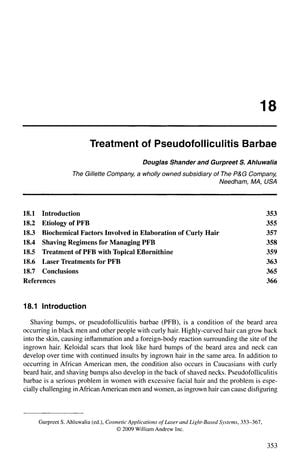TLDR Combining proper shaving, topical treatments, and laser therapy effectively reduces Pseudofolliculitis Barbae.
The document reviewed various treatments for Pseudofolliculitis Barbae (PFB), a condition common in individuals with curly hair, particularly African American men. It highlighted that daily shaving, especially when combined with glycolic acid, significantly reduced PFB lesions, with a study showing a 60% reduction in lesions after 12 weeks in 11 men. Topical eflornithine applied twice daily for 16 weeks reduced ingrown hairs by 44% and improved PFB in 9 out of 11 men. Laser treatments, including ruby, alexandrite, and Nd:YAG lasers, also showed promise in reducing PFB lesions. The document concluded that a combination of ideal shaving regimens, topical treatments, and laser use could maximize treatment efficacy while minimizing adverse events and costs.
85 citations
,
October 2007 in “International Journal of Dermatology” Curly hair shape is due to uneven growth patterns in the hair follicle.
125 citations
,
February 2007 in “Journal of the American Academy of Dermatology” Combining eflornithine cream with laser treatment removes facial hair better than laser alone.
88 citations
,
March 2004 in “Journal of Investigative Dermatology” 35 citations
,
October 2003 in “Dermatologic clinics” Laser therapy on darker skin has higher risks and needs expert handling.
96 citations
,
February 2002 in “Journal of the American Academy of Dermatology” Pseudofolliculitis barbae is a chronic skin condition affecting mainly African American and Hispanic individuals, caused by shaving tightly curled hair, and managed by prevention and treatment but not curable.
17 citations
,
July 1977 in “International Journal of Dermatology” Proper shaving techniques and specific topical treatments can help manage pseudofolliculitis barbae.
16 citations
,
April 2020 in “Dermatology practical & conceptual” Laser treatment can effectively reduce unwanted hair growth, particularly for people with fair skin and dark hair.
February 2020 in “The Pharmaceutical Society of Japan”  30 citations
,
May 2018 in “Experimental Dermatology”
30 citations
,
May 2018 in “Experimental Dermatology” The conclusion is that future hair loss treatments should target the root causes of hair thinning, not just promote hair growth.
1 citations
,
January 2009 in “Elsevier eBooks” The chapter explains why and how women remove unwanted hair, comparing methods like shaving and waxing.
 1 citations
,
September 2002 in “PubMed”
1 citations
,
September 2002 in “PubMed” Minoxidil helps stimulate hair growth and reduce hair loss in women with androgenic alopecia.
61 citations
,
January 2002 in “American Journal of Clinical Dermatology”


